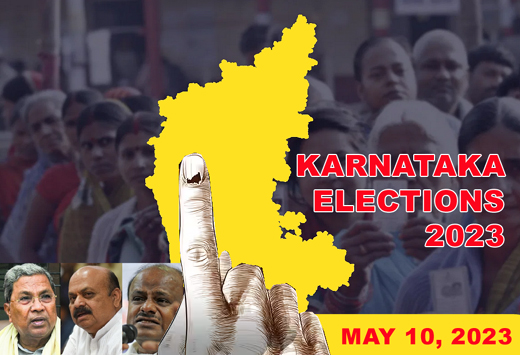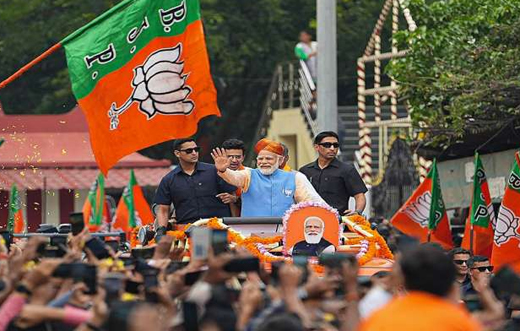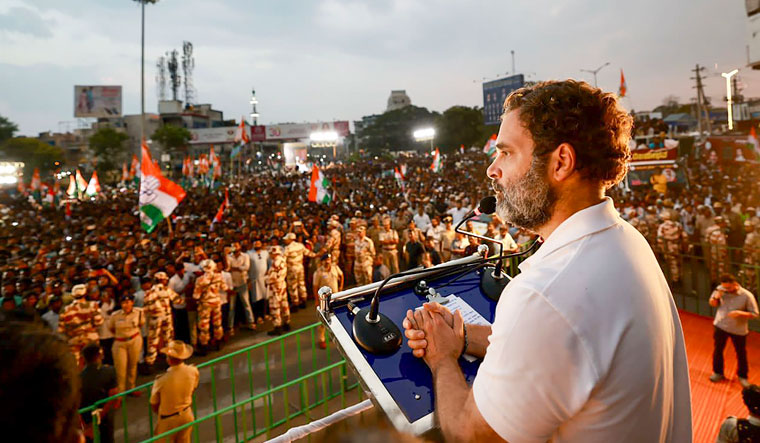Karnataka elections: Will the Congress be able to dodge the Modi wave?
Karnataka elections: Will the Congress be able to dodge the Modi wave?
Mangalore Today News Network
By Chris Emmanuel D’souza
Mangaluru, May 8, 2023: As India’s ranking in the 2023 World Press Freedom index slides down to 161 out of 180 countries in the report released by global media watchdog Reporters without Borders (RSF), Prime Minister Modi and Home minister Amit shah are gearing up to sweep and retain yet another state in their clutch. India is currently behind Pakistan, Srilanka, Afghanistan and many African countries and only inches above North Korea and Iran!
Caste, religion,hate speech and Horse Trading are some of the treasured features of modern Indian elections. The only body that has to keep these things in check is the Election Commission; a body that is as good as a limping horse in recent times. One of the chronic characteristics of Karnataka politics in the last few decades is the rate of defections among its politicians, days before and after the elections, taking voters for a ride.Karnataka politicians have repeatedly shunned their ideological leanings and their moral principles before monetary and political rewards.

In a sharp contrast to the central and other states, Karnataka is one of the last few remainingprovinces in India that has a significant Congress presence through a wide range of party cadre deeply ingrained at the grass root level. Congress Party’s Karnataka Supremo Siddaramaiah, who belongs to the Kuruba (Sheppard) tribe, a Backward caste has a mass appeal cut across corners of the state. Siddaramaiah is a political veteran and first entered the Vidhan Sabha in the 1983 Assembly elections on Bharatiya Lok Dal ticket. He was a close confidant of HD Devegowda and served as the Finance Minister in his cabinet during the Janata Dal tenure 1994-99 in the state. In the mid 2000’s during the acrimonious political chaos in the state, Siddaramaiah reinvigorated the faded ‘Ahinda’ movement, a social consolidation Dalits, Backward castes and religious minorities. For this, hewas showed the door from the party by his own guru Devegowda. Siddaramaiah was left without a party and willingly joined a declining Congress party. Siddaramaiah stiffened and fortified the Congress through padayatrasand his verbal wrestles with the opposition in the assembly. This time in the election, He has a right-hand man in DK Shivkumar (Karnataka Congress Secretary). Shivkumar belongs to the Vokkaliga Caste which makes up roughly about 14% of the State’s voter baseand he is the state’s congress campaign strategist. Apart from his job of looking after the Party’s affairs, Shivkumar is a millionaire businessman, has been labeled as the party’s money bag and through his long stint has played pivotal roles at various occasions over the years in holding the pillars of the congress party in the state.
Caste is unfortunately a focal point in the Karnataka elections since its inception. The BJP has played the caste card rathercannily ever since the unceremonious dismissal of former Congress chief minister Veerendra Patil through the orders of Rajiv Gandhi in 1989. Veerendra Patil, a mass congress leader with a Lingayat background singlehandedly helped the Congress party win a massive landslide 1989 assembly elections but a fatal stroke had left him paralyzed within a year. Meanwhile, the LK Advani lead Ram Jamna Bhoomi movement was intensifying across the country and had its aftershocks in the form of communal riots in some of the coastal areas of the state. The situation shook Rajiv Gandhi and exposed his indecisiveness, he showed no mercy on Patil’s condition and replaced him. The Lingayat community which makes over 15% of the state’s voting population took the snubbing of their leader very seriously and switched to the rising BJP in the early 90’s. The congress permanently lost the Lingayat vote base ever since, and BJP propelled the momentum by pushing BS Yeddyurappa (BSY), another Lingayat stalwart to the fore.

PM Modi rally in Bangalore

Rahul Gandhi rally in Kolar
The BJP for several decades was seen as a party of the upper caste and had a scarce existence in handful of towns. Since its inception in 1951 by personalities affiliated to the Sangh Parivar(RSS), the BJP (then called Jan Sangh) had rallied itself as a flag bearer of Nationalism and soft Hindutva. For decades, despite having acclaimed orators and leaders like Atal Bihari Vajpayee, Jan Sangh was ridiculed in the political circles and the larger public wasn’t able to grasp it intentions. In the late 80’s and early 90’s backed by its Ram Mandir movement and the subsequent demolition of ‘Babri Masjid’ and the disturbances that followed, the party cashed in on sensitivities and swayed a huge section of the population. This era saw a steady riseof BJP in the coastal Karnataka belt (South Canara and North Canara) with dedicated assistance from outfits like Bajrang Dal and VHP. In the 1994 State Elections the BJP under BSY (Yeddyurappa) won 40 seats from a meagre 4 seats in 1989 elections. By the 2000’s the BJP had surmounted itself as a major political party heavily pumped by boots on the ground outfits attached to the Sang Parivar. The party won the largest mandate in the 2004 Assembly elections with 79 seats and yet wasn’t able to form a coalition government. However, four years later with all the political circus the Party won 108 Assembly seat under the leadership of BSY and formed the government on its own.
Since 1999, there has never been a decisive mandate for any party with the exception of 2013, when Siddaramaiah lead congress party turned the tables with 122 seats. Therefore, much like the last election results there is a possibility of a hung assembly, where a ‘Joker in the pack’ comes to play the kingmakers role. Here, HD Kumaraswamy and his JDS would finally decide the fate of a forming a government. The JDS is significantly strong among the Vokkaligga (Gowda) community spread across old Mysore regions. The JDS has its roots in the original Janata party which was a nationwide Anti-Indira Gandhi coalition force formed in 1977. The Janata Party was a cocktail of range of ideologies from extreme socialists to extreme right wingers. The Karnataka divisionof Janata party was boosted and vitalized in the early eighties by famed regional stalwarts like Ramkrishna Hegde, S R Bommai, HD Devegowda and former Indian defence minister George Fernandes. In 1983, The Janata Party under Ramkrishna Hegde formed the first non-Congress government in the state with an alliance with BJP. However due to the Janata Party’s massive setback in the 1984 General Elections, Hegde dissolved his government and went for reelectionin 1985 and won with a even larger mandate with 139 Assembly seats a full majority to form an independent government. But despite anoverwhelming mandate and increasing popularity of Ramkrishna Hegde, the party came in loggerheads with senior leaders like Devegowda in a tussle for power grab. The party suffered a humiliating setback in the ’89 elections and thus Devegowda decided to part ways and form Janata Dal. Under Devegowdas leadership the Janata Dal won 115 seats in the 1994 Assembly elections and successfully formed the government with Devegowda as the Chief Minister.
The Dakshina Kannada and Udupi Conundrum
The BJP with the help of Hindutva outfits have engineered and mobilized a large majority of the population in the coastal belt of Karnataka over the years. Tons of Media personnel from TV and Youtube have been covering the build up to theKarnataka elections and have expressed astonishment in witnessing the amount unilateral devoted support to the BJP in the region, even surpassing UP and Gujarat. In South Canara (DK), the BJP had opened its account in the early 80’s and for the last thirty years, except for one odd term the BJP has totally dominated the polls.On the other hand, The congress has fielded a Catholic candidate in the Mangalore South constituency since 1972 keeping in mind a considerable catholic population in the city. Although LC Pais, father of eminent Mangalorean lawyer Clarence Pais won the seat in the regions first ever assembly elections held in 1952, when it came under Madras state. Addy Saldanha was elected on a congress ticket in 1972, PF Rodrigues in 1978, Blasius Dsouza was elected 1985 and 1989.JR Lobo, a former IAS officer won the constituency in the 2013 elections and worked tirelessly and became one of the most respected political personalities in the state. However, due to the South Canara’s heavy winds lost the 2018 edition to Vedvyas Kamath. There has been The Catholic population in Mangalore city has declined over the years due to various reasons, and the congress party might have just missed the bus in noticing these changes.
Due to the Anti-Incumbency and results of the unauthentic and unreliable state opinion polls that had given the congress an upper hand, the party seemed to be riding high with confidence for months. However, with the last-minute grand slam visit of Prime Minister Narendra Modi through his massive road shows and speeches, might have put their campaign on a back foot. The congress party do not have a ‘Modi’ in their kitty, for that matter they lack a ‘Star’ National leader. On the contrary, the Gandhi family is an extra-baggage to the state leadership of congress, since the general public show no enthusiasm to the High Command. In fact, it is Siddaramaiah’s singular popularity, especially in the rural belt of Karnataka that the party is able to capitalize, resist and hold on against a cash rich BJP that has one of the finest Election Management projects in the world.The congress and certain sections of the media have long ignored the impact of the ‘Modi factor’ in any elections. There has never been a national leader as charismatic as Prime Minister Modi and there has never been a Prime Minister who has shown such obsession towards winning an election. Through his ardent and lucid oratory, Modi has mastered the ‘Art of persuasion’, something which no other contemporary politician is able to match.
After the success of ‘Operation Kamala’ in 2019 the BJP under Yeddyurappa mismanaged the Covid crisis through unprecedented lockdowns depriving the poor, the daily wage labourers, the street vendors, drivers etc from earning their daily bread. Moreover, in the last two years a considerable number of people have lost their jobs or their small businesses and have become poorer. The rise in prices for edible oil, LPG, Fuel and other groceries have made the poor and the downtrodden sections of the society extremely contemptuous against the ruling state BJP. One of the trending narratives against the BJP has been accusation of corruption or in other words ‘40% Sarkara’, where there have been several reported cases against the party members in blackmailing civil contractors. In the last leg, there has been every attempt to communalize the rhetoric with venomous speeches. Despite several stumbling blocks, the BJP has not lost any love with the larger urban middle class in the state. The Bangalore’s IT crowd adores Prime Minister Modi as one of their deities. The middle class are not the beneficiaries of government schemes, they do not care for a Party’s social programs. Therefore, a price hike may not affect a middle-class individual’s lifestyle, whereases it does to a poor. There is absolutely no doubt that the deciding factor in this years elections would be toss between the admiration for a leader or an ideology versus putting food on the table.
- Need For ‘Students, Alcohol and Drugs’ survey
- New Synthetic Drugs Trapping Youth
- Mood Modifying Chips - Future of Drug Use
- Ramping up Indo-Bangla border security
- IITM- A premier educational Institution in a forest. What can we learn?
- Former PM, Manmohan Singh: Notable laws passed under his tenure
- Hashish on Ratnagiri Seashore
- The Poor cry out to Us: Do we respond?
- Clandestine Meth Labs Sprouting Across India
- Hydro ganja from Bangkok latest craze among youth in India
- "Memories to Treasure" Dr.Michael Lobo’s new book
- Dominance of Private Universities: Will it make education inaccessible to underprivileged students?
- Monti Phest: A rich heritage of South Canara
- Kashmir Bhavan in Bengaluru: A must visit place
- "MAI and I" Book of Angelic Emotions
- Draupadi Murmu - The New ’President of India’
- Anthony Ashram in the city grows a classic museum
- First College of Fisheries in India - A Golden Jubilarian
- Flushing Meadows - A Vintage Mansion
- The Colonel�s Bequest
- A Mangalorean PM and his RBI Governor Brother: The Extraordinary story of the Benegal Brothers
- There is no higher religion than Truth: Theosophical Society
- L�affaire - Ashu & Yiju of Mangalore
- Mangalore in Kowloon
- 1568 to 2018 AD: 450 years of Christianity in Mangaluru
- Vice President elect Naidu moves on from nadir to zenith, the phenomenal journey
- Embracing the Outdoors: How Heated Jackets Are Revolutionizing Cold Weather Activities
- Efficient and Sustainable Packaging Solutions with FIBCs
- The Hybrid Kilt Revolution | Where Tradition Gets Trendy
- Affordable Elegance | Embrace Style on a Budget with Cheap Kilts
- Unleashing Style and Functionality | Exploring Tactical Kilts
- Mangalore’s Heroic Lady marks 105th Birthday
- Santa the Christmas spirit
- Geriatric care: Mangalore strikes a fine balance
- The Don Who Made Two Empires to Clash
- CHITRAPUR SARASWATS - A Great Kanara Community
- Our new President Ram Nath Kovind’s significant journey to Rashtrapathi Bhavan
- Marriages made in heaven, big fat weddings made in India
- Eid insight - The giver of glad tidings
- CITY INFORMATION
- TRAVEL
- TOURIST INFORMATION
- HEALTH CARE
- MISCELLANEOUS




 Write Comment
Write Comment E-Mail To a Friend
E-Mail To a Friend Facebook
Facebook Twitter
Twitter  Print
Print 


